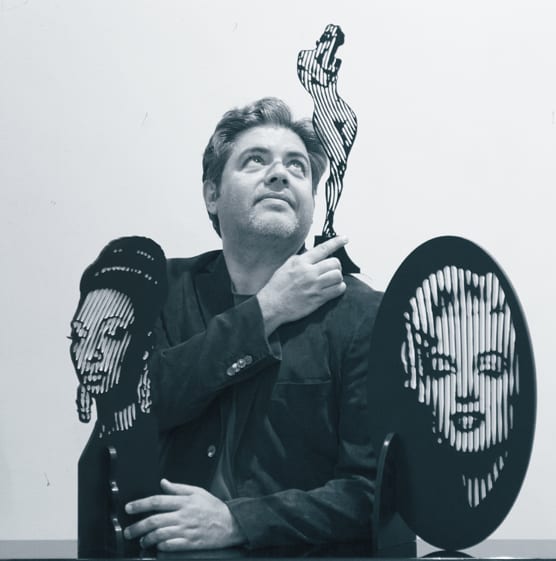Our Q&A with Monaco’s Brazilian community
talks to internationally acclaimed artist Marcos Marin

ML: Could you tell me about your background?
MM: I was born and grew up in Sao Paulo. My mother is Lebanese and my father, who worked for the Brazilian theatre and cinema, is Spanish. It was my father who inspired me to pursue an artistic career. I started playing the piano at a very early age, at 5 years old, in fact.
ML: You say your country has an “innate richness” and you are a proud to have Brazilian identity. How does your culture different from others?
MM: There is something wonderful about being Brazilian, the positivity, the enthusiasm and sincerity. Brazil is part of the “new world”. We have the sun of the tropics and our culture is a rich blend of African, indigenous and European, where the social codes are different. Brazil has taken these influences and mixed them to create its own identity. Another major difference is the perception of space. Brazil is huge, and has a universe of possibilities still to be explored.
ML: How did destiny bring you to Monaco?
MM: My story with Monaco started with a meeting with Delphine Pastor during the Art Basel Miami Beach fair in 2004. She had discovered my work – I was living in Miami at the time – and invited me to exhibit my art in her recently opened gallery, the Gismondi Pastor gallery in Monaco. The exhibition was well received and one of my portraits of Princess Grace was selected to be part of the collection of the new Monaco Modern’Art museum. Prince Albert II later commissioned a monumental work in honour of his father Prince Rainier III, which was inaugurated January 18, 2006. I was travelling frequently between Miami and Monaco when finally I was invited by Pierre Cardin to come and live and work in Lacoste, a village in Luberon, a three-hour drive from Monaco. Pierre Cardin became my patron and I started to create monumental sculptures. My career in the Principality had evolved enormously and, in 2009, I had the opportunity to set up my studio and my home in Monaco.
ML: You are trained as an artist in plastic and as pianist. How did your career evolve?
MM: I trained as a classical pianist and moved from Sao Paulo to Paris in the 1990s where I met the great master Vasarely, who inspired me to create my optical portraits. My music career gradually gave way to an artistic career as a painter and sculptor. As my works of art started to become recognised and win awards, I moved to Miami and contributed to the artistic effervescence that was there in the early 2000s. My work was exhibited in collections of major museums in the US, and my return to Europe with Delphine Pastor, meetings with Prince Albert and patron Pierre Cardin gave a huge drive to my career. A number of public monuments are installed in and around Monaco, such as Coco Chanel in Cap Martin, Cocteau in the citadel of Villefranche-sur-mer and a whole series of large sculptures of Princess Grace and other members of the royal family are presented every year. I became a member of the Academy of Arts and Letters in Portugal and my contact with the arts patron Stanley Ho of Macau enabled me to produce some major works in Asia, in Hong Kong and Macau in particular. This, along with several commissions for official portraits from royal families and presidents around the world, means that I have travelled extensively!
In Paris, in 2011 I was the guest artist to celebrate Coca Cola’s 125th anniversary and I joined the great masters in the art collection of the Coca Cola Museum in Atlanta USA.
My collaboration with the Prince Albert II Foundation has resulted in a commitment and a series of works dedicated to the cause.
ML: How is music and the world of art different in Brazil from other countries Brazil, say Monaco as an example?
MM: Each country’s culture evolves differently depending on its influences, its economic opportunities, history, tradition, and reputation in a specific field.In Europe, classical music is at the highest level, with the best academies. In Brazil, the “bossa nova” is becoming a reference for excellence around the world. Brazil also has a very strong art market, both domestic, with the great masters, and on the world stage where Brazil participates in the largest international contemporary art fairs.
ML: What do you enjoy most about living in Monaco?
MM: I appreciate many aspects of living in Monaco, the security, obviously, and the organisation, but also the beauty of the area. I think it is a privilege to live here. I am very active in the local Brazilian community, particularly in the Brasil-Monaco Project, which I contribute to with my artworks.
ML: You visit Brazil often. What do you think of Rio as Host to the Olympics this summer.
MM: As for the Olympics, despite all the criticism and the difficult political context, I think for Rio de Janeiro to host the games it’s an opportunity to advance, to be creative and to experience the intensity and positivity that such an event can bring – just what the Brazilian people need. The opening ceremony was sublime! Very original, very “ARTY”! Bravo!
For more on Marcos and his work, visit artmarcosmarin.com from August 21.
READ MORE ABOUT MONACO’S BRAZILIAN COMMUNITY
The Honorary Consul of Brazil in Monaco
Luciana de Montigny, President and Founder of the Brasil Monaco Project
Severiano Alves-Pereira,Executive Director J. Safra Sarasin Bank
Tereza Mahot, NavigatorsYachtClub.com
